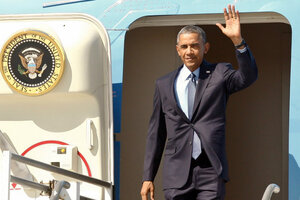Obama in the Golden State: Will he notice California's spoiled sunshine?
Here's what the president may not see at his top-dollar fundraising events: California has the highest poverty rate, nearly the highest unemployment rate, and, according to CEOs, the worst business climate in the nation.

President Obama steps off of Air Force One at Los Angeles International Airport on Thursday. He is beginning a three-day trip.
Damian Dovarganes/AP
President Obama is making a trip to California. He has come here on a number of occasions, but these trips have probably not given him an accurate picture of the state. He has spent much of his California time at top-dollar political fundraising events, where mere millionaires have to watch the billionaires get the best tables.
Those Californians are doing fine. The rest of us, not so much.
Unemployment here is well above the national level; in fact, only six states and the District of Columbia have higher rates of joblessness. The picture is even bleaker when you look at the “U-6” unemployment rate from the Bureau of Labor Statistics. This figure provides a fuller unemployment picture by including those “marginally attached to the labor force,” plus those “employed part time for economic reasons.” California ties with Nevada for the highest U-6 rate, at 16.2 percent.
With poverty, likewise, things go from bad to worse when you delve into the statistics. The state’s official poverty rate of 14.9 percent is above the national level of 14.5 percent. Of the 25 most populous metropolitan areas in the country, California’s Riverside-San Bernardino-Ontario area had the highest poverty rate at 18.2 percent. And by another census measure, which takes a more comprehensive view of living costs, California had the highest poverty rate in the country in 2012, at 23.8 percent.
The Census Bureau has also recently released a study that measures the income gap between the rich and poor on a scale from 0 (no inequality) to 1 (full inequality.) With a score of .490, California had the fifth-highest level of inequality, surpassed by only the District of Columbia, New York, Connecticut, and Louisiana.
Why are things so bad for so many Californians? According to a survey of chief executive officers, California has the nation’s worst business climate, largely because of taxation and regulation. Living costs are higher here than anywhere else, except for New Jersey, New York, Hawaii, and the District of Columbia.
Economic mobility depends on education. Only three states and DC have higher teacher salaries than California. But according to one study, California ranks 39th in the quality of its schools.
Even the good news about California is marbled with bad. Yes, we have managed to avoid budget crises in recent years. But one reason is a 2012 tax increase. Another is the state’s dependence on the rich. The top one percent of Californians – those with incomes over a half a million dollars – pay more than 50 percent of the state’s total personal income tax. These people – the kind that the president meets – derive much of their income from investments. If the stock market goes down – as it inevitably will – state revenues will plummet and the budget crises will come back.
Back in 1998, President Clinton attended a fundraising dinner at the home of a Hollywood mogul. The president said: “I want to ask you to just think about one thing briefly and seriously, and that is, okay, California is back.” In fact, the dot-com bubble had merely given the state an illusion of prosperity. Soon the bubble burst and the state fell on hard times.
If President Obama wants to make any public comments about California, he should avoid making that mistake. If he takes a hard look outside, he will see that the Golden state’s sunshine is badly spoiled.
Jack Pitney writes his Looking for Trouble blog exclusively for the Monitor.

